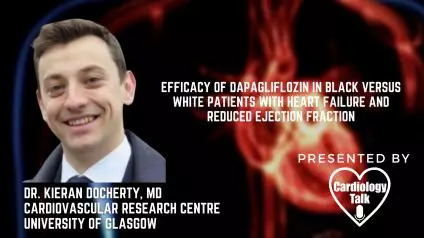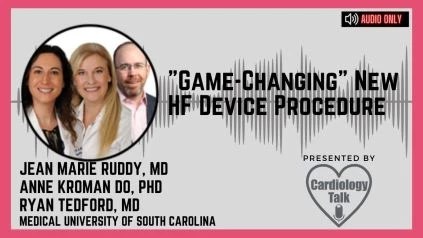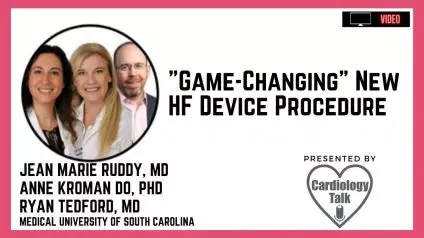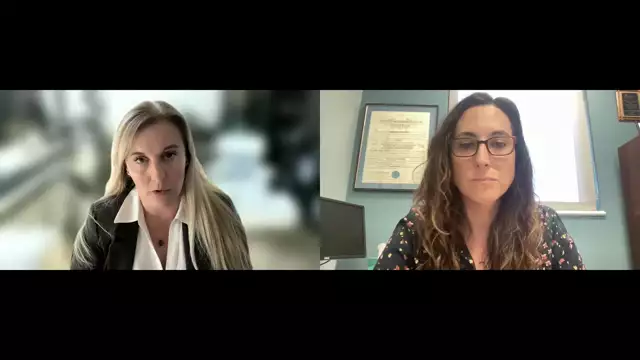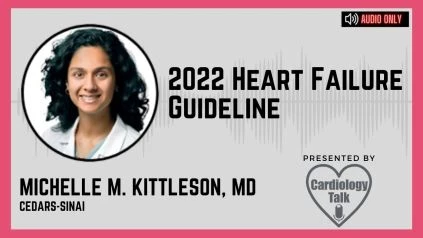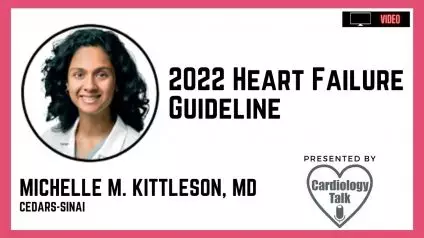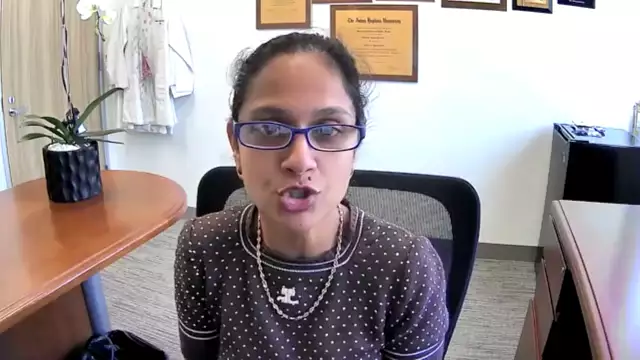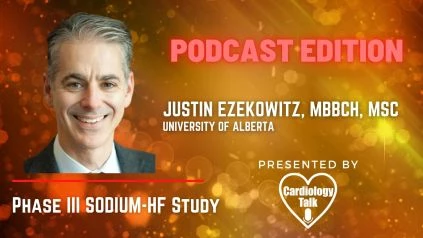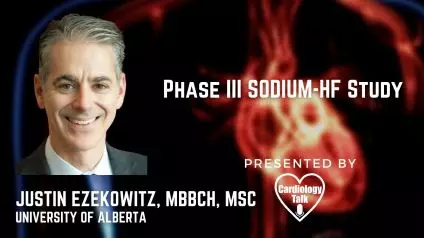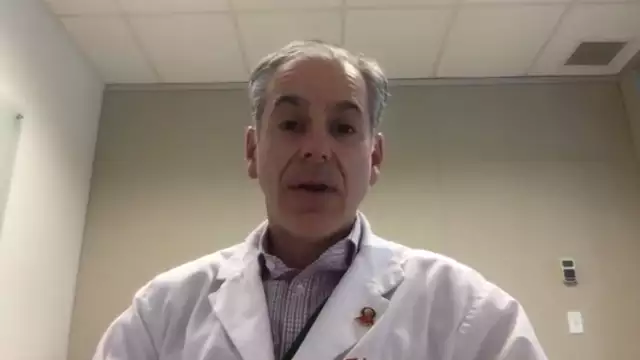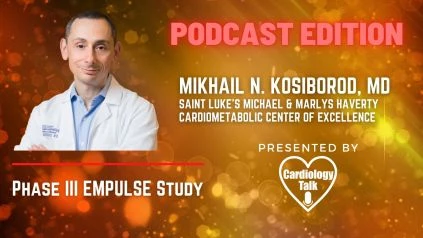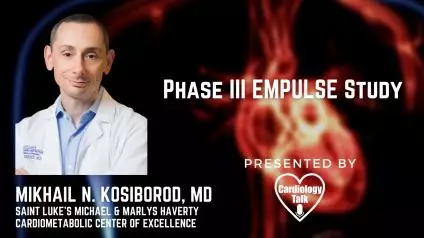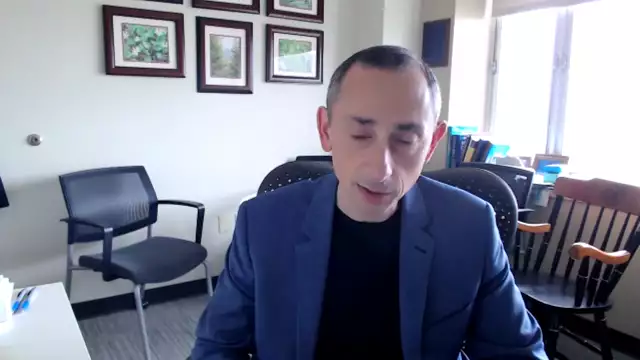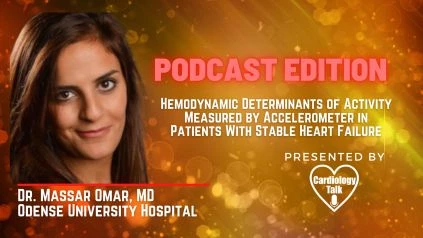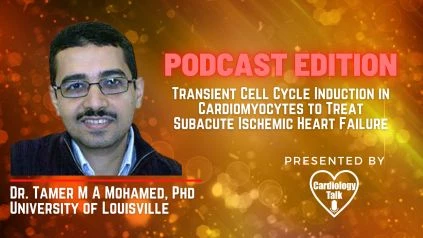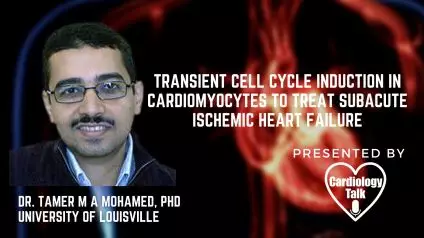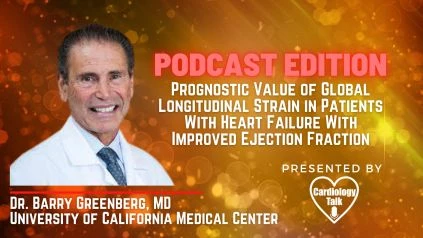Dr. Kieran Docherty, MD- Efficacy of Dapagliflozin in Black Versus White Patients With Heart Failure and Reduced Ejec...
From 2005 to 2011, Kieran Docherty studied medicine at the University of Glasgow. He is a Cardiology Specialist Registrar in the West of Scotland Deanery and a Clinical Research Fellow at the University of Glasgow's Institute of Cardiovascular and Medical Sciences. In this video Dr. Docherty discusses Efficacy of Dapagliflozin in Black Versus White Patients With Heart Failure and Reduced Ejection Fraction.
Link to Abstract-
https://www.jacc.org/doi/10.1016/j.jchf.2021.08.006
Abstract-
The goal of this study was to look at the efficacy and safety of dapagliflozin in patients with heart failure (HF) with decreased ejection fraction (HFrEF) who were included in the DAPA-HF trial (Study to Evaluate the Effect of Dapagliflozin on the Incidence of Worsening Heart Failure or Cardiovascular Death in Patients With Chronic Heart Failure).
Background
Certain medications for HFrEF may affect black individuals differently than white people.
Methods
DAPA-HF was designed for patients with New York Heart Association functional classes II to IV, an ejection fraction of less than 40%, and an increased N-terminal pro–B-type natriuretic peptide. Because more than 99% of Black patients were randomized in the Americas, this post hoc analysis solely looked at Black and White patients from North and South America. A worsening HF episode (HF hospitalization or urgent HF visit requiring intravenous therapy) or cardiovascular mortality was the primary outcome.
Results
The Americas accounted for 1,494 (31.5%) of the 4,744 participants randomized in DAPA-HF. There were 1,181 Whites (79.0%) and 225 Blacks (15.1%) among them. When compared to White patients, Black patients had a greater rate of worsening HF episodes, but not mortality. Dapagliflozin reduced the risk of the primary endpoint in Black (HR: 0.62; 95 percent CI: 0.37-1.03) and White patients (HR: 0.68; 95 percent CI: 0.52-0.90; P-interaction = 0.70) patients similarly to placebo. Other prespecified outcomes, such as the composite of total (first and repeat) HF hospitalizations and cardiovascular death (P-interaction = 0.43) and the Kansas City Cardiomyopathy Questionnaire total symptom score, showed consistent improvements. In either Black or White individuals, study drug discontinuation and major adverse events were not more common in the dapagliflozin group than in the placebo group.
Conclusions
Dapagliflozin relieved symptoms and lowered the risk of worsening HF and cardiovascular death in both Black and White patients, with no increase in side events. (DAPA-HF; NCT03036124; Study to Evaluate the Effect of Dapagliflozin on the Incidence of Worsening Heart Failure or Cardiovascular Death in Patients With Chronic Heart Failure)
Introduction
In heart failure (HF), racial and ethnic differences in etiology, incidence, prevalence, disease burden, and treatment response are well known, with particularly dramatic discrepancies between Black patients and others in the United States (1-3). The association of very high rates of hospitalization and death among Black patients with possible decreased effectiveness of essential pharmacological therapy, such as renin-angiotensin system inhibitors and some beta blockers, is of special concern (1-5).
Patients who identify as Black have different demographics, comorbidities, socioeconomic variables, health behavior, and access to health care than those who do not, and these disparities may influence treatment outcomes and outcomes (1-5). The possible reduced response to angiotensin-converting enzyme inhibitors, angiotensin receptor blockers, and beta blockers in Black patients may be due to genetic and other traits related to African ancestry, such as heightened salt sensitivity and lower activity of the renin-angiotensin-aldosterone system (1-6). To make matters even more complicated, assessing the effectiveness of treatments in Black patients is typically challenging due to their under-representation in clinical trials (1,3). Because of the few incidents in a small number of Black patients, it is often impossible to provide a reliable estimate of the effect of therapy. Nonetheless, due of their high risk and the uncertainty regarding the usefulness of some traditional medicines, it is critical to evaluate the efficacy and safety of new treatments in Black patients (7-10).
Sodium glucose cotransporter 2 (SGLT2) inhibitors have recently been found to lower cardiovascular risk in type 2 diabetic patients, while there is some debate about their efficacy in Black individuals (11). SGLT2 inhibitors have been shown to be an effective treatment for patients with HFrEF, regardless of their diabetes history (12-14). In this paper, we compare the effects of this innovative therapeutic method in Black and White patients in the DAPA-HF (Study to Evaluate the Effect of Dapagliflozin on the Incidence of Worsening Heart Failure or Cardiovascular Death in Patients With Chronic Heart Failure) study (12). Because more than 99 percent of Black patients were enrolled in the Americas, the White patients in this study were likewise from North and South America.
Methods
The DAPA-HF trial investigated the efficacy and safety of dapagliflozin 10 mg once daily versus a comparable placebo addition to routine therapy in individuals with HFrEF. The trial's design and major findings have been published (12). The procedure was approved by ethical committees at all 410 participating institutions in 20 countries, and all patients gave written informed consent.
Patients in the research
Men and women aged 18 years and older who had been diagnosed with HF for at least two months were eligible if they were in NYHA functional classes II to IV, had a left ventricular ejection fraction (LVEF) of 40%, had a modest elevation of N-terminal pro–B-type natriuretic peptide (NT-proBNP), and were receiving optimal pharmacological and device therapy. Symptoms of hypotension or a systolic blood pressure (SBP) of 95 mm Hg, an estimated glomerular filtration rate (eGFR) of 30 mL/min/1.73 m2, and type 1 diabetes were all key exclusion factors.
Race categories that have been predetermined
White, Black or African American, Asian, Native Hawaiian or other Pacific Islander, American Indian or Alaska Native, or "other" were the pre-specified race subgroups, according to US Food and Drug Administration guidance (15). On the case report form, patients were assigned to a race subgroup based on their self-identification.
Clinical results
The primary outcome was a composite of cardiovascular death or an episode of worsening HF (HF hospitalization or an urgent visit for worsening HF where intravenous treatment for HF was delivered), whichever came first. The trial's secondary outcomes included the occurrence of HF hospitalization or cardiovascular death (we also looked at the components of the primary composite), total HF hospitalizations (first and repeat), change in the Kansas City Cardiomyopathy Questionnaire (KCCQ) total symptom score (KCCQ-TSS) from baseline to 8 months, a composite endpoint of worsening renal function, and all-cause death. This outcome was not evaluated in the current subgroup analysis due to the minimal number of renal incidents overall. Changes in eGFR, SBP, body weight, and hematocrit from baseline were among the exploratory objectives.
Serious adverse events, adverse events resulting to randomized treatment cessation, and adverse events of interest, such as volume depletion, renal adverse events, bone fracture, amputation, significant hypoglycemia, and diabetic ketoacidosis, were all included in prespecified safety studies. Patients who had received at least one dosage of either dapagliflozin or placebo were analyzed for safety. (The safety analysis excluded eight randomized participants.)
Analyses statistical
The frequency with percentage, mean with SD, or median with IQR were used to summarize the baseline characteristics. The chi-square test was used to examine differences in baseline characteristics for categorical variables, while the Wilcoxon test and 2-sample Student's t-test were used to test differences in baseline characteristics for non-normal and regularly distributed continuous variables, respectively.
The Kaplan-Meier estimator and Cox proportional hazards models were used to calculate HRs, 95 percent CIs, and 2-sided P values for the primary and secondary clinical outcomes according to race, regardless of treatment allocation. Data were stratified by diabetes mellitus status, with a history of HF hospitalization and treatment group assignment as fixed-effect factors. As previously reported, semiparametric proportional-rates models were used to evaluate the whole, including recurrent occurrences (12). There was no adjustment for history of HF hospitalization in the models for all-cause death. The methods outlined were used to investigate the interaction between race and treatment effect, with the addition of a race-by-treatment interaction term in the models. Age, heart rate, SBP, BMI, HF etiology, LVEF, NYHA class, log NT-proBNP, atrial fibrillation, and eGFR were also provided, as were adjusted HRs from models that included age, heart rate, SBP, BMI, HF etiology, LVEF, NYHA class, log NT-proBNP, atrial fibrillation, and eGFR.
Responder analyses were conducted, with the treatment effect expressed as an odds ratio, and missing KCCQ values were accounted for with multiple imputation using methods described previously, examining proportions of patients with a deterioration (decrease in KCCQ-TSS of 5 points) and clinically important improvement (increase in KCCQ-TSS of 5 points) in symptoms, physical function, and health-related quality of life at 8 months according to race (12).
A mixed-effects model for repeated measurements was used to assess longitudinal parameters such as eGFR, SBP, body weight, and hematocrit (adjusted for baseline values, visit, randomized treatment, and interaction of treatment and visit with a random intercept and slope per patient). The 95 percent confidence intervals for the least-squares mean differences between treatment groups were calculated and presented for each group.
In a logistic regression model containing a race-by-treatment interaction term, the interaction between race and the effect of treatment on the occurrence of the prespecified safety outcomes was examined. All analyses were carried out with Stata 16.1 (Stata Corp) and SAS 9.4 (SAS Institute) (SAS Institute). A statistically significant P value of 0.05 was used.
Results
1,494 (31.5%) of the 4,744 patients randomized in DAPA-HF were from the Americas (North America: 677 [14.3 percent ]; South America: 817 [17.2 percent ]). There were 1,181 Whites (79.0%) and 225 Blacks (15.1%) among them. 121 (53.8%) and 104 (46.2%) of the 225 Black patients were enrolled in North America and South America, respectively. Only one patient (0.1%) identified as Native Hawaiian or other Pacific Islander, four (0.3%) as American Indian or Alaska Native, twenty (1.3%) as Asian, and 63 (4.2%) as "other" (ie, all others: n = 88 [5.9%]). Only patients who are Black or White are mentioned further.
Characteristics of Patients
White patients were significantly older (mean age: 63 years) than Black patients (mean: 67 years). Women made up a bigger proportion of Black patients (34.7 percent) than White patients (24.7 percent) (Table 1). Black patients had a higher BMI and SBP than White patients, as well as a greater prevalence of hypertension and diabetes.
